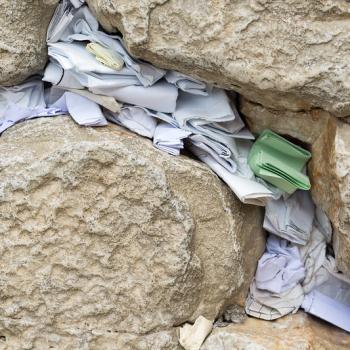
Breathe in the positive. Let go of what no longer serves. Whether we are on the yoga mat or being coached through a moment of anxiety, the call to expand our lungs with an inhalation of positive energy feels basic to centering practices. It makes sense. We fill ourselves with life-giving air. We pause. We let go of the oxygen-depleted breath and along with it, we release tension and negative thoughts. Attention to our breath lives hand-in-hand with spiritual practice. Spirit itself is breath. The focus, however, is almost always on the nourishing swell of the inhale. What if we could change our exhale? What if the exhale carried the power of the positive?
As we explore the basic elements of prayer, from water to earth to air, the call to be aware of the air that flows in and through and out of us is the same call to pray without ceasing that Paul offered in his letter to the Thessalonians. If we can connect our prayer to our breath, then we might feel that which some call spirit moving within and beyond us. And we will also hold prayer in every movement of our day. Spiritus – the Latin word for breath. A blowing, rushing breath. Like the Hebrew ruach. We draw it into our beings, and it fills us with life. And it fills us with the narrative of our life. And with the stories of all those who have breathed that same air.
Breathing in the Story
In my Latin class, gathered in a circle on the floor, we call in the spirit of the Musa. Musa mihi fabulam memora. Muse, remember the story for me. And with a giant inhale, I receive the story of those who have gone before us. The story is passed on to another group of students, who will perhaps hold it tightly and pass it on themselves one day. In one breath, the Muse inspires. Here again, the focus is on the intake of the breath. The inspiration. It gives us the story. But what is this story if not shared? The beauty of the oral tradition that has given us everything from the Torah to the Odyssey to the Tao Te Ching is in the passing of the story. When the inhale becomes exhale, the connection is made. From those past to those yet to be. From me to you. From life-receiving to life-giving.
Tonglen: the Buddhist Practice of the Exhale
Buddhist nun Pema Chödrön, in her book Welcoming the Unwelcome, writes about the Buddhist understanding of bodhichitta. The awareness of connecting with our difficult emotions (pain, rage, fear, loss, grief, isolation, shame) in order to awaken to the suffering of the world and our desire to alleviate the suffering of the world. She says, “When we arouse bodhichitta, we commit to overcoming everything that obscures our innate wisdom and warm-heartedness, everything that cuts us off from our natural ability to empathize with and benefit others.” Our practice of connecting with our own suffering allows us to benefit others. She explains that we can awaken this bodhichitta through a very simple practice called tonglen.
We breathe in our pain, and breathe out strength.
During the practice we expand this to breathing in the pain of others, those we know and those we do not. Those who might be suffering exactly what we are.
We breathe in their pain, and breathe out wellbeing to them.
We breathe in heaviness; breathe out light.
In this meditative practice, we connect ourselves to all beings through our exhale. We change the perspective of the exhale, which now becomes the positive and life-connecting flow.
In this chart, connect to the suffering that you or those throughout this world might be experiencing. In meditative breaths, breathe in the pain, and breathe out the positive.


The Exhale of the Divine
In Jewish tradition the very name of the divine is synonymous with breath. The tetragrammaton, the four-letter two-syllable sound for YHWH, is thought to be the inhale and exhale of the limitless name: I am who I am, I will be who I will be. The opening verse of the Nishmat Kol Chai prayer calls on the name of God from all beings that breathe.
נִשְׁמַת כָּל חַי
תְּבָרֵךְ אֶת שִׁמְךָ
יְהֹוָה אֱלֹהֵינוּ.
The breathing soul of all life
Will bless your name
Adonai/YHWH, our God.
We take in the breath that utters the name of the limitless one. We exhale the breath that is the completion of the name. The extension of the divine into the world, from us to all living and breathing beings. We are the breath of the divine, and in our praise and in our lament, we exhale. We call to the breath: “Come from the four winds, O breath, and breathe upon these slain, that they may live.” (Ezekial 37:9) And in a beautiful confluence of our mortal exhale and the exhale of the divine, life comes to a pile of dry bones.
Our two words for breathing in English are both rooted in Latin words. Spirare: the rushing, blowing breathing that enters with purpose. Halare: that gives us our inhale and exhale, the natural flow of air that comes without any intention other than just being. May our prayers be filled with both. Filled with the spirit that rushes into our dry bones and gives us life. And balanced with an inhale and exhale, both rooted in the life-giving energy of connectedness.

















